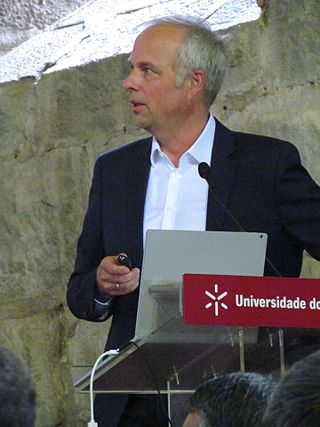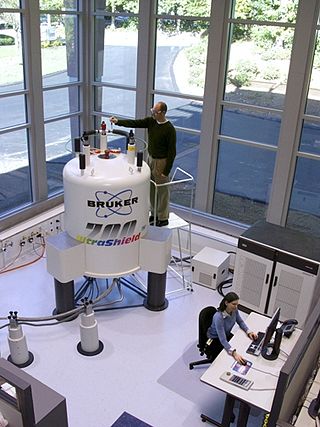Related Research Articles

Spectroscopy is the field of study that measures and interprets electromagnetic spectra. In narrower contexts, spectroscopy is the precise study of color as generalized from visible light to all bands of the electromagnetic spectrum.
Fourier-transform spectroscopy is a measurement technique whereby spectra are collected based on measurements of the coherence of a radiative source, using time-domain or space-domain measurements of the radiation, electromagnetic or not. It can be applied to a variety of types of spectroscopy including optical spectroscopy, infrared spectroscopy, nuclear magnetic resonance (NMR) and magnetic resonance spectroscopic imaging (MRSI), mass spectrometry and electron spin resonance spectroscopy.
Solid-state physics is the study of rigid matter, or solids, through methods such as solid-state chemistry, quantum mechanics, crystallography, electromagnetism, and metallurgy. It is the largest branch of condensed matter physics. Solid-state physics studies how the large-scale properties of solid materials result from their atomic-scale properties. Thus, solid-state physics forms a theoretical basis of materials science. Along with solid-state chemistry, it also has direct applications in the technology of transistors and semiconductors.
Dynamic nuclear polarization (DNP) results from transferring spin polarization from electrons to nuclei, thereby aligning the nuclear spins to the extent that electron spins are aligned. Note that the alignment of electron spins at a given magnetic field and temperature is described by the Boltzmann distribution under the thermal equilibrium. It is also possible that those electrons are aligned to a higher degree of order by other preparations of electron spin order such as: chemical reactions, optical pumping and spin injection. DNP is considered one of several techniques for hyperpolarization. DNP can also be induced using unpaired electrons produced by radiation damage in solids.
Microwave spectroscopy is the spectroscopy method that employs microwaves, i.e. electromagnetic radiation at GHz frequencies, for the study of matter.

Electron paramagnetic resonance (EPR) or electron spin resonance (ESR) spectroscopy is a method for studying materials that have unpaired electrons. The basic concepts of EPR are analogous to those of nuclear magnetic resonance (NMR), but the spins excited are those of the electrons instead of the atomic nuclei. EPR spectroscopy is particularly useful for studying metal complexes and organic radicals. EPR was first observed in Kazan State University by Soviet physicist Yevgeny Zavoisky in 1944, and was developed independently at the same time by Brebis Bleaney at the University of Oxford.
Ferromagnetic resonance, or FMR, is coupling between an electromagnetic wave and the magnetization of a medium through which it passes. This coupling induces a significant loss of power of the wave. The power is absorbed by the precessing magnetization of the material and lost as heat. For this coupling to occur, the frequency of the incident wave must be equal to the precession frequency of the magnetization and the polarization of the wave must match the orientation of the magnetization.
Herbert Sander Gutowsky was an American chemist who was a professor of chemistry at the University of Illinois Urbana-Champaign. Gutowsky was the first to apply nuclear magnetic resonance (NMR) methods to the field of chemistry. He used nuclear magnetic resonance spectroscopy to determine the structure of molecules. His pioneering work developed experimental control of NMR as a scientific instrument, connected experimental observations with theoretical models, and made NMR one of the most effective analytical tools for analysis of molecular structure and dynamics in liquids, solids, and gases, used in chemical and medical research, His work was relevant to the solving of problems in chemistry, biochemistry, and materials science, and has influenced many of the subfields of more recent NMR spectroscopy.

Jörg Wrachtrup is a German physicist. He is director of the 3rd Institute of Physics and the Centre for Applied Quantum Technology at Stuttgart University. He is an appointed Max Planck Fellow at the Max Planck Institute for Solid State Research in Stuttgart. Wrachtrup is a pioneer in solid state quantum physics. Already in his PhD thesis, he carried out the first electron spin resonance experiments on single electron spins. The work was done in close collaboration with M. Orrit at the CNRS Bordeaux. To achieve the required sensitivity and selectivity, optical excitation of single molecules was combined with spin resonance techniques. This optically detected magnetic resonance is based on spin dependent optical selection rules. An important part of the early work was coherent control. As a result the first coherent experiments on single electron spins and nuclear spins in solids were accomplished.

The Institute of Physics (IOP) of the National Academy of Sciences of Ukraine founded in 1926 is the oldest research institution of physical science within the academy. Being on the path of both infrastructure development and research diversification for more than 80 years, the institute has eventually originated five more specialized research institutions.

Nuclear magnetic resonance (NMR) is a physical phenomenon in which nuclei in a strong constant magnetic field are perturbed by a weak oscillating magnetic field and respond by producing an electromagnetic signal with a frequency characteristic of the magnetic field at the nucleus. This process occurs near resonance, when the oscillation frequency matches the intrinsic frequency of the nuclei, which depends on the strength of the static magnetic field, the chemical environment, and the magnetic properties of the isotope involved; in practical applications with static magnetic fields up to ca. 20 tesla, the frequency is similar to VHF and UHF television broadcasts (60–1000 MHz). NMR results from specific magnetic properties of certain atomic nuclei. Nuclear magnetic resonance spectroscopy is widely used to determine the structure of organic molecules in solution and study molecular physics and crystals as well as non-crystalline materials. NMR is also routinely used in advanced medical imaging techniques, such as in magnetic resonance imaging (MRI). The original application of NMR to condensed matter physics is nowadays mostly devoted to strongly correlated electron systems. It reveals large many-body couplings by fast broadband detection and it should not to be confused with solid state NMR, which aims at removing the effect of the same couplings by Magic Angle Spinning techniques.
Electron nuclear double resonance (ENDOR) is a magnetic resonance technique for elucidating the molecular and electronic structure of paramagnetic species. The technique was first introduced to resolve interactions in electron paramagnetic resonance (EPR) spectra. It is currently practiced in a variety of modalities, mainly in the areas of biophysics and heterogeneous catalysis.
David Hardy Whiffen FRS was an English physicist and pioneer of infrared and Electron Spin Resonance known for the "Whiffen Effect".
Nuclear spectroscopy is a superordinate concept of methods that uses properties of a nucleus to probe material properties. By emission or absorption of radiation from the nucleus information of the local structure is obtained, as an interaction of an atom with its closest neighbours. Or a radiation spectrum of the nucleus is detected. Most methods base on hyperfine interactions, which are the interaction of the nucleus with its interaction of its atom's electrons and their interaction with the nearest neighbor atoms as well as external fields. Nuclear spectroscopy is mainly applied to solids and liquids, rarely in gases. Its methods are important tools in condensed matter physics, solid state chemistry., and analysis of chemical composition.

Modern spectroscopy in the Western world started in the 17th century. New designs in optics, specifically prisms, enabled systematic observations of the solar spectrum. Isaac Newton first applied the word spectrum to describe the rainbow of colors that combine to form white light. During the early 1800s, Joseph von Fraunhofer conducted experiments with dispersive spectrometers that enabled spectroscopy to become a more precise and quantitative scientific technique. Since then, spectroscopy has played and continues to play a significant role in chemistry, physics and astronomy. Fraunhofer observed and measured dark lines in the Sun's spectrum, which now bear his name although several of them were observed earlier by Wollaston.
William Hayes is an Irish-born physicist and academic administrator, active in the United Kingdom.
{{Infobox scientist | name = Marina Bennati | workplaces = [[Max Planck Institute for multidisciplinary Sciences]
[University of Göttingen]]
Goethe University Frankfurt
Massachusetts Institute of Technology | alma_mater = University of Stuttgart
University of Münster | thesis_title = Zeitaufgelöste Elektronen-Spin-Resonanz an photoangeregten Zuständen spezieller Donor-Akzeptor-Systeme | thesis_url = http://www.worldcat.org/oclc/258062810 | thesis_year = 1995 }}
References
- ↑ biographical information from American Men and Women of Science, Thomson Gale 2004
- ↑ Watkins, George D. (1952). A R. F. Spectrometer with Applications to Studies of Nuclear Magnetic Resonance Absorption in Solids. Bibcode:1952PhDT........14W.
- 1 2 "George Watkins | Array of Contemporary American Physicists". Archived from the original on 2016-04-28. Retrieved 2016-04-07.
- ↑ George D. Watkins, National Academy of Sciences
- ↑ International ESR/EPR Society - Awards [ permanent dead link ]